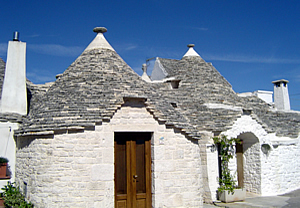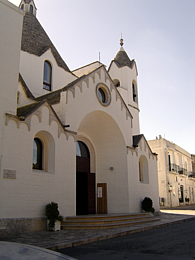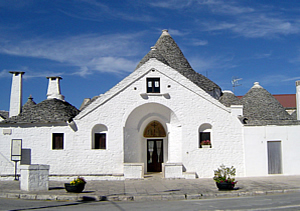Alberobello the trulli town
Ostuni
- Origins of Ostuni
- What to see in Ostuni
- Events in Ostuni
- Practicalities
- Seaside of Ostuni
- Masserie of Ostuni
- Trulli
- Museum of Ostuni
- Parks and protected areas
- Cuisine
- Images of Ostuni
- Ostuni local info
- Getting to Ostuni
Rentals
Services
- Property and land management
- Guest management
- Property restoration and reparing works
- Taxi service and taxi sharing service
- Services for disabled
Excursions
Food & Wine
Alberobello. Origins
The origins of Alberobello date back to the second half of the 16th century, when, under the rule of the Acquaviva family, Counts of Conversano, the area was populated by peasants who were ordered, by the Counts, to build stone houses without mortar. The reason for this was that they could be easily dismantled in case of a royal inspection in order to not pay the duty to the Bourbons.
The order to build mortarless houses was not well accepted by the population that still had to pay duty to the Counts and was forced to tear down their homes at each inspection.
Over the years the discontent grew to the point that in the late 18th century, exactly the 10th of May 1797, seven brave citizens of Alberobello met King Ferdinand of Bourbon and asked for full independence from the Counts of Conversano.
Convinced by the words of the seven citizens the king, on the 27th of May of that year, forwarded a dispatch to Alberobello in which he sanctioned the end of the political and economic subjugation of the town under the feudal lord, the Count of Conversano. Thanks to this Alberobello finally became a royal and free town.
Aberobello Tourist Info Office
Address: Via Monte Nero, 3
Phone number: +39 080 432 2060
Distance from Ostuni: 47.5 km
Time to get there by car: about 45 minutes
Aberobello eBook guide

Places in Puglia: Alberobello and the trulli houses
A fully comprehensive guide of Alberobello: what to see in town and in the surrounding area; best restaurants; wine bars; ice-cream parlours; sport; shopping; general info and the practicalities. Plus 4 useful maps: historic centre map, territory map, Puglia train map, map of main places of interest in Puglia.
E-book for Kindle, Ipad, Iphone, Smartphone, Tablet, PC e Mac.
Get it from Amazon.co.uk
Get it from Amazon.com
What to see in Alberobello
Rione Aia Piccola

Rione Aia Piccola is the oldest and most picturesque district of Alberobello. There are 400 trulli distributed along eight streets.
Rione Aia Piccola, whose name refers to a large open space that was once used for threshing grain, is a very picturesque district thanks to its alleys, winding streets and charming corners that recall a fairy tale.
Here, it is not possible to visit the inside of the trulli as most of them are private homes.
Rione Monte

Rione Monti, which stretches south of the city, is characterized by the presence of about 1000 trulli. It is a very scenic district with streets and stairways flanked by the most beautiful trulli of Alberobello.
Although nowadays it has become a commercial area with many souvenir shops it has retained its charm with enchanting corners, colourful streets and squares with a unique style.
Chiesa di Sant'Antonio

The Church of Sant'Antonio, built in 1927, is located at the top of the hill of the Rione Monti. It is a trulli shaped church with a rose window above the entrance.
It has a Greek cross shape with side chapels and a bell tower next to one of these chapels.
Trullo Sovrano

The Trullo Sovrano, which was declared National Monument in 1930, is the only example in Alberobello of a trullo with two floors. It was built in the mid-18th century by the family of the priest Cataldo Perta.
It function as a small museum because of its architecture and because it provides an insight into life within the trulli. It was built without mortar and is an extraordinary example of high technical skills.
Casa Pezzolla - Museo del Territorio
Casa Pezzolla is a cluster of 15 trulli built in the 18th century, all communicating with each other. This group of buildings now belongs to the local council and houses the Museo del Territorio.
The museum houses a permanent exhibition of architectural traditions of Alberobello with displays of tools, findings and evidence relating to the history and traditions of the territory of the trulli.
Piazza XXVII Maggio
Open Monday to Sunday: from 10.00 to 13.00 and from 15.30 to 19.00.
Ostuni
- Origins of Ostuni
- What to see in Ostuni
- Events in Ostuni
- Practicalities
- Seaside of Ostuni
- Masserie of Ostuni
- Trulli
- Museum of Ostuni
- Parks and protected areas
- Cuisine
- Images of Ostuni
- Ostuni local info
- Getting to Ostuni
Rentals
Services
- Property and land management
- Guest management
- Property restoration and reparing works
- Taxi service and taxi sharing service
- Services for disabled
Excursions
Food & Wine







